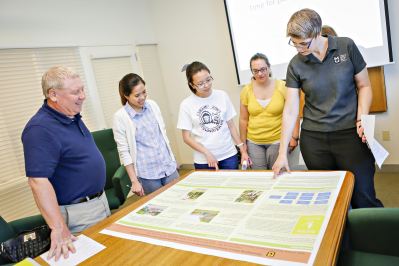Teaching for Learning: Instructional Design
Update December 2020:
This web page is a companion to the 2016 version of the School Library Program Rubric. NYSED released an updated School Library Program Rubric in December 2020.
Student Snapshot: Students acquire, evaluate, and use information effectively through instructional strategies designed to meet learner needs.
According to the Faculty Center for Teaching and Learning (n.d.) instructional design, “involves purposeful and systematic planning of a course (or components of a course). It is a process that begins with an analysis of the intended student learning outcomes, identifies teaching strategies and student activities to enable students' achievement of the outcomes, and ends with the development of multiple methods to assess whether and to what extent the outcomes were achieved”. Instructional Design is also developing and organizing materials, resources, activities, and assessments based on instructional theory and best practices from the field which include the research of how people learn; knowing when to use particular instructional strategies in the course of a learning event; identifying tools that are best suited to meet a learning goal; identifying where problems may arise in the implementation of instruction; and knowing why instruction is or was effective or ineffective (Hovius 2015).
Source: Faculty Center for Teaching and Learning. "What Is Instructional Design?". Ferris State University.
Source: Hovious, Amanda. "What Is Instructional Design and Technology?" CILIP: Chartered Institute of Library and Information Professionals, 8 June 2015.
Citation for Photo: Spradley, Kyle. CAFNR Spring Training. 2014. Flickr.
This web page features a photo from Kyle Spradley, available under Creative Commons Attribution-NonCommercial 2.0 Generic license.
In Practice
The Empire State Information Fluency Continuum
Description: The ESIFC emphasizes the importance of inquiry in learning and establishes information fluency standards for grades K-12, which are aligned with Common Core Learning Standards. The fusion of the two sets of standards aims to create students who are capable of absorbing and applying appropriate information to any situation. The document identifies three information literacy standards which encourage students to be thinkers, explorers, and citizens and outlines the essential steps of inquiry: connect, wonder, investigate, construct, express, and reflect. The continuum also includes grade-specific benchmarks for information skill development and sample diagrams and worksheets which may be used to assess students’ progress. Finally, there is a helpful chart for administrators, teachers, and librarians that links progress along the fluency continuum with various Common Core Learning Standards in reading, writing, and speaking & listening. The continuum helps apply Common Core Learning Standards to real-world classroom teaching and is a great resource to use for grade-specific lesson planning.
Resource/Citation: New York City School Library System. “The Empire State Information Fluency Continuum”. Engage NY. Engage NY, 7 Nov. 2014.
Understanding by Design Framework
Description: A white paper on the Understanding Design Framework that provides “a planning process and structure to” support the development of curriculum, assessment practices, and instruction.
Resource/Citation: McTighe, Jay and Grant Wiggins. “Understanding by Design Framework”. ASCD, 2012.
Evidence-Based Practice
Description: The January/February 2015 Knowledge Quest theme is evidence-based practice. As educators, school librarians must “actively engage in professional and reflective practices that chart, measure, document, and make visible the impact of school libraries on learning outcomes” (Todd 2015). This issue investigates how school librarians can measure their effect on student learning objectives.
Resource/Citation: American Association of School Librarians. “Evidence-Based Practice.” Knowledge Quest, vol. 43., no. 3, 2015, January/Februay 2015, pp. 82.
Using instructional design principles to develop effective information literacy instruction: The ADDIE model
Description: A widely recognized model of instructional design, ADDIE is examined with specific examples drawn from information literacy instruction. “The ADDIE model consists of five steps: analysis, design, development, implementation, and evaluation. It is a strategic plan for course design and may serve as a blueprint to design IL assignments…” Using the ADDIE model of ID lends itself to collaboration with teacher colleagues. It “helps identify an entry point for the project, which is helpful for a new or inexperienced instructional librarian.”
Resource/Citation: Davis, Angiah L. “Using instructional design principles to develop effective information literacy instruction: The ADDIE model.” College & Research Libraries News, vol. 74, no. 4, 2013, 205-207.
Librarians as Instructional Designers: Strategies for Engaging Conversations for Learning
Description: In this blog post, high school librarian Buffy J. Hamilton recommends strategies for librarians to use as instructional designers while collaborating with teachers. She describes how she made the most of a collaboration challenged by time constraints, designing resources that guided students toward inquiry without clashing with the class’s needs.
Resource/Citation: Hamilton, Buffy J. "Librarians as Instructional Designers: Strategies for Engaging Conversations for Learning." The Unquiet Librarian, 6 Dec. 2013.
The “Flexible” Curriculum of the Library Learning Commons
Description: The LIITE Model of curriculum design is presents an alternative to “the set curriculum based on coverage at each grade level.” LIITE is a flexible curriculum that “demonstrates how a teacher librarian can add "light" to any learning experience during a co-taught learning experience” (Loertscher n.d.).
*Resource/Citation: Loertscher, David V. “The Flexible Curriculum of the Library Learning Commons.” Teacher Librarian, vol. 43, no. 3, Feb. 2016, p. 50.
The Making of an Instructional Design Librarian
Description: Lindsay O’Neill’s blog post describes the early experiences of a new university librarian, and suggests strategies and tools for developing instructional design materials. O’Neill considers how instructional design intersects with librarians’ tasks, and explains how she chooses projects that combine the two.
Resource/Citation: O'Neill, Lindsay. "The Making of an Instructional Design Librarian." ACRLog, 20 Jan. 2015.
In Theory
Library Media Standards: Second Edition
Description: Library Media Standards describes what accomplished teachers should know and be able to do. The standards are meant to reflect the professional consensus at this point about the essential aspects of accomplished practice.
Resource/Citation: National Board for Professional Teaching Standards. “Library Media Standards: Second Edition”. National Board for Professional Teaching Standards, 2012.
Rethinking Pedagogy for a Digital Age:Designing for 21st Century Learning, 2nd Edition
Description: Through a critical discussion of the issues surrounding the design, sharing and reuse of learning activities, the second edition of Rethinking Pedagogy for a Digital Age examines a wide range of perspectives on effectively designing and delivering learning activities to ensure that future development is pedagogically sound, learner-focused, and accessible.
*Resource/Citation: Beetham, Helen, and Rhona Sharp, eds. Rethinking Pedagogy for a Digital Age: Designing for 21st Century Learning. 2nd ed., Routledge, 2013.
About UDL: Resources
Description: The National Center on Universal Design for Learning provides a number of resources on Universal Design for Learning (UDL), many of which hold relevance for librarians. UDL is a set of principles that ensure that educational materials are equally accessible to all learners. These resources include videos, presentations, articles, and links to support implementation of UDL principles.
Resource/Citation: National Center on Universal Design for Learning. "About UDL: Resources". National Center on Universal Design for Learning, 2014.
Motivational Design in Information Literacy Instruction
Description: The inherently cross-curricular nature of Information literacy instruction in which “learners demonstrate information-seeking behaviors” makes it essential that librarians design instruction that considers motivational design. This resource provides theories of motivational design, information literacy instruction as it addresses motivational design, and implications for 21st century IL instruction.
Resource/Citation: Hess, Amanda Nichols. "Motivational Design in Information Literacy." Communications in Information Literacy, vol. 9, no. 1, 2015, pp. 44-59.
Consultant
Name: Doreen Bergman
Email: DBergman@ocmboces.org
Bio: Doreen is the School Library System Coordinator at OCM BOCES in Syracuse. She holds certifications in Childhood Education, School Library Media, and Building and District Educational Leadership. She was previously both an elementary and secondary librarian and a classroom teacher.
*To access restricted database articles or books speak with your school librarian or public librarian.







